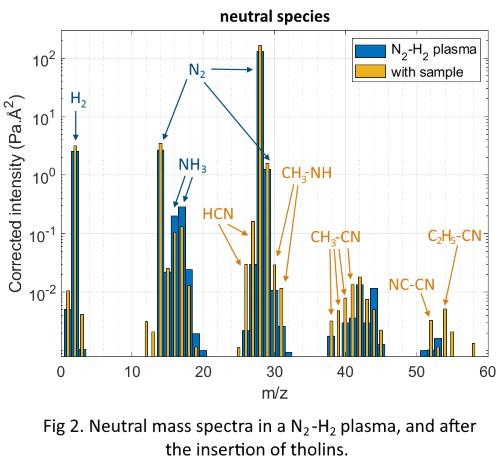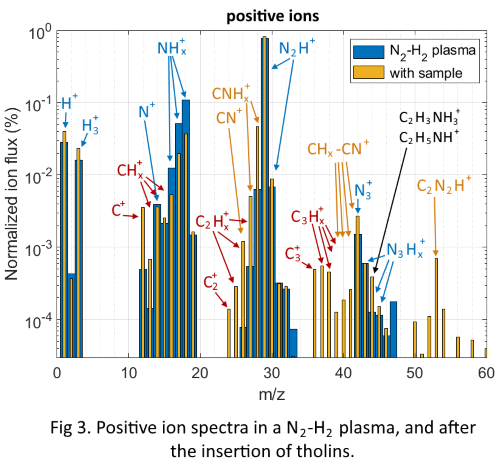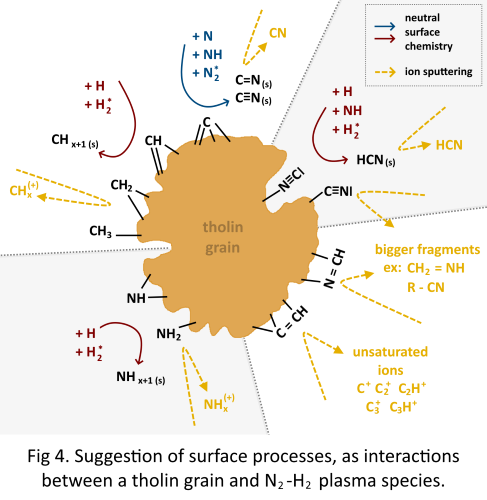Interaction aerosols - plasma in Titan ionosphere: effect on the gas phase composition
- 1Université Paris-Saclay, UVSQ, CNRS, LATMOS, Guyancourt, France (audrey.chatain@latmos.ipsl.fr)
- 2LPP, Ecole polytechnique, Sorbonne Université, université Paris-sud, CNRS, Palaiseau, France
Abstract
Titan’s aerosols start forming in the ionosphere, in a reactive environment hosting electrons, ions and radicals. In this work we study the interaction of the aerosols with the ‘carbon free’ plasma species. In this objective, analogues of Titan’s aerosols (tholins) are exposed to a N2-H2 plasma in the laboratory. A previous work observed modifications on the solid aerosols [1]. Complementarily, this study investigates a possible feedback of the tholins erosion on the gas phase composition. The decrease of ammonia and the formation of carbon-bearing (and especially nitrile-bearing) species is observed by neutral and ion mass spectrometry. We suggest surface processes combining reactions with radicals and ion sputtering to explain these observations.
1- Introduction
Saturn’s biggest moon, Titan, has a thick atmosphere of N2 and CH4 (2-5%), covered by a haze of orange organic aerosols. The mission Cassini discovered that these aerosols start forming around 900 – 1200 km, in the ionosphere [2]. The ionosphere is the upper part of the atmosphere, ionized by UV solar photons and energetic particles from Saturn’s magnetosphere. It therefore hosts reactive plasma species (electrons, ions, radicals, excited species) that are likely to interact with the newly formed aerosols.
Carbon-bearing species help the carbon growth of the aerosols, but what is the result of the interaction of the aerosols with the other plasma species? Laboratory analogues of Titan’s aerosols can be formed in plasma discharges (e.g. in the experiment PAMPRE, Szopa et al., 2006); they are called ‘tholins’. A few studies have previously studied the effect of extreme UV photons on tholins [4], [5], and the recombination of atomic hydrogen at the surface of tholins [6].
Nevertheless, the interaction of Titan’s aerosols with the other ‘carbon-free’ plasma species has never been studied before. We built a dedicated experimental setup to expose tholins to a N2-H2 plasma (named ‘THETIS’ for THolins Evolution in Titan’s Ionosphere Simulation). The evolution of the tholins have previously been analysed by IR absorption spectroscopy and reported in Chatain et al. (2020a). We observed a physical erosion of the grains (with holes of ~20 nm) and chemical changes (disappearance of isonitriles and unsaturated structures, and formation of a new nitrile band).
In this context, the aerosols erosion is likely to have a feedback effect on the composition of the gas phase in Titan’s ionosphere. In this work, we therefore investigate the modifications of the gas phase during the exposure of tholins to a N2-H2 plasma.
2- The experimental setup
The ionosphere of Titan ‘free of carbon species’ is simulated by a DC glow plasma discharge in N2-H2 (with up to 5% H2). The pressure is varied from 0.5 to 2 mbar, and the current from 10 to 40 mA. Tholins formed in PAMPRE are spread on a thin metallic grid, which is exposed to the plasma during the experiment. The gas phase composition (neutrals and positive ions) is measured by a mass spectrometer (EQP series from Hiden), whose collecting head is positioned at ~5 cm from the plasma glow, next to the grounded electrode (see Figure 1). The mass spectrometer transmittance has previously been finely determined [7] to enable a quantitative comparison between all the mass intensities.
3- Evolution of neutral species
Figure 2 shows mass spectra acquired close to the N2-H2 plasma discharge, without (blue) and with (yellow) the tholins sample. Ammonia (NH3), which is formed in the N2-H2 plasma, decreases with the insertion of tholins in the plasma. It suggests that ammonia or its precursors are consumed by tholins. On the opposite, we observed the production of HCN and other carbon-containing molecules. Most of them contains nitriles (-CN), like acetonitrile (CH3-CN) and cyanogen (C2N2).

4- Evolution of positive ions
Figure 3 similarly presents mass spectra without (blue) and with (yellow) tholins exposed to the N2-H2 plasma. Observations are consistent with the evolution of neutral species: ammonia related ions (NHx+) are formed in the N2-H2 plasma and decrease with the addition of tholins; HCN related ions (CN+, HCN+, HCNH+) increase strongly; and new carbon-containing ions are formed. Among those we observe nitrile-bearing ions (related to acetonitrile and cyanogen), and highly unsaturated hydrocarbons (C+, CH+, C2+, C2H+, C3+, C3H+…).

5- Conclusions on the production of new volatiles by heterogeneous chemistry
From the evolution of the gas phase species observed in this work, the modifications of the tholins chemical functions presented in Chatain et al. (2020a) and previous heterogeneous chemistry modelling work in microelectronics [8], we suggest in Figure 4 some surface processes.
Radicals are likely to chemically react with the tholins. In particular, we suggest that an interaction of tholins carbon atoms with the radicals N, NH and H leads to the formation of HCN(s) (which stays adsorbed at the surface). In parallel, ion sputtering ejects fragments of tholins into the gas phase. It is especially the case for HCN which is already a stable molecule. This could also explain the nitrile-containing species and the highly unsaturated hydrocarbon ions observed in the previous sections. In addition, NH is fundamental in the production of NH3. The fact that NH is used at the surface of tholins to form HCN(s) is a reasonable explanation to the decrease of ammonia production.
In conclusion, in parallel to their formation in the ionosphere of Titan, aerosols are likely to undergo heterogeneous erosive processes and be a source of new volatiles. It would be interesting to implement such processes in the ionospheric chemical models.

Acknowledgements
A.C. acknowledges ENS Paris-Saclay Doctoral Program. N.C. acknowledges the financial support of the European Research Council (ERC Starting Grant PRIMCHEM, Grant agreement no. 636829).
References
[1] A. Chatain et al. Icarus 345 (2020)
[2] J. H. Waite et al. Science 316 (2007)
[3] C. Szopa et al. Planet. Space Sci. 54 (2006)
[4] N. Carrasco et al. Nat. Astron. 2 (2018)
[5] S. Tigrine et al. Astrophys. J. 867 (2018)
[6] Y. Sekine et al. Icarus 194 (2008)
[7] A. Chatain et al. Plasma Sources Sci. Technol. (2020)
[8] K. Van Laer et al. Plasma Sources Sci. Technol. 22 (2013)
How to cite: Chatain, A., Carrasco, N., Vettier, L., and Guaitella, O.: Interaction aerosols - plasma in Titan ionosphere: effect on the gas phase composition, Europlanet Science Congress 2020, online, 21 September–9 Oct 2020, EPSC2020-454, https://doi.org/10.5194/epsc2020-454, 2020

